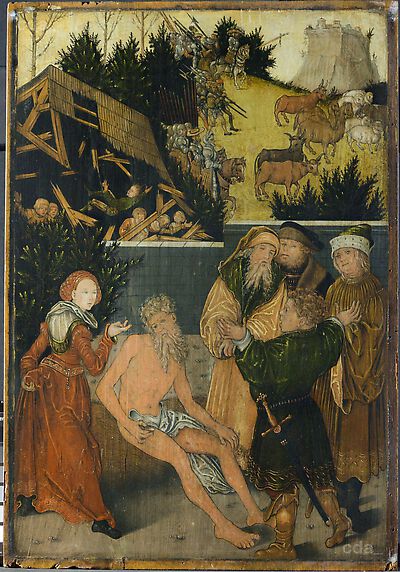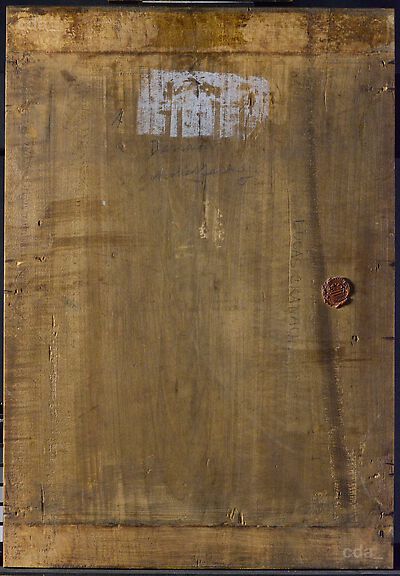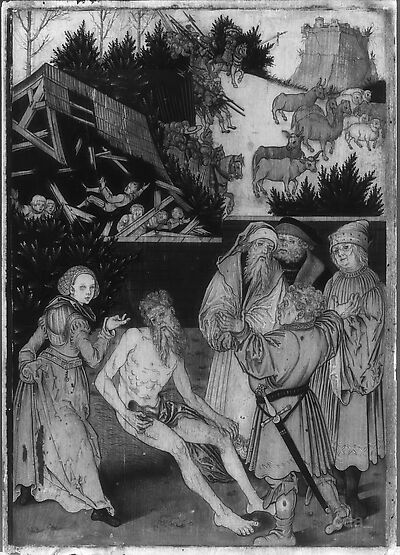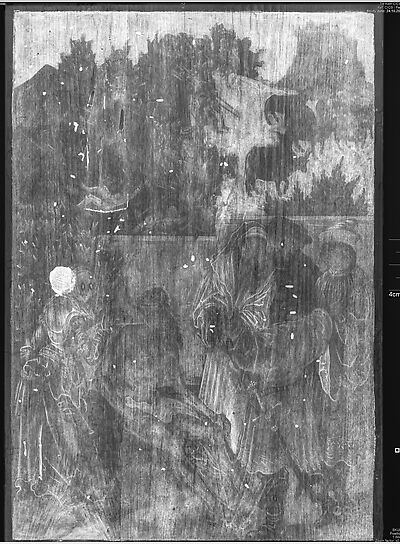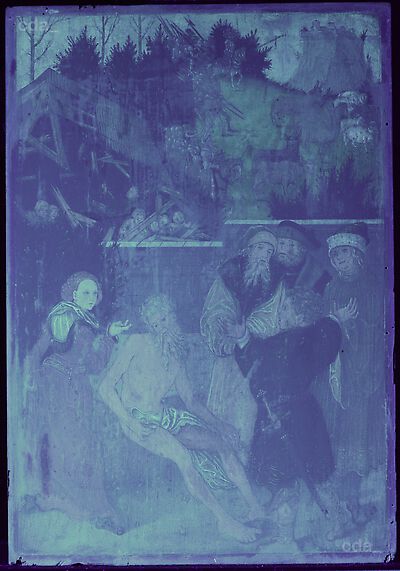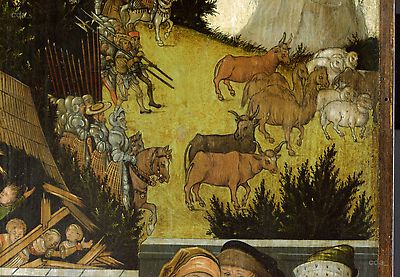Support
The support consists of two planks, butt-joined and glued (top from the l.: 9.6 / 19.7 cm, bottom from the left: 9 / 20.3 cm).
It would appear to be a hardwood species (deciduous tree).
Ground and Imprimatura
The ground is very thin and white. XRF analysis (Niton XLt) detected the following elements: lead (lead white) and calcium (probably chalk). Optically numerous protrusions are indicative of an interaction between lead white and oil, suggesting that it is an oil-based ground.
The high lead white content of the ground has made the pores in the wood more visible in the x-radiograph (Seifert ERESCO 150KV/0,5mA/Examion CR 3X-pro).
An exposed strip of the wooden support measuring c. 0.7 cm in width is visible on all four sides of the panel. This suggests that the panel was fixed in a frame when the ground was applied.
No such thin ground applications have to date been found on any of the panels securely attributed to the Cranach workshop.
Underdrawing
The composition initially defined with a fluid, black medium and a brush. It is after a woodcut by Cranach from 1524, exhibiting only minor deviations e. g. the woman’s dress and the head of the man on the left. However, the detailed underdrawing is different in character to those found on other works firmly attributed to Cranach or his workshop.
Paint Layers and Gilding
Using XRF analysis (Niton XLt) various elements were detected in the paint and by comparing their optical characteristics the following pigments were identified:
Red: Pb: lead white; Zn: zink white (?); Hg: vermillion; Fe: iron oxide/ ochre; Cu: blue or green pigment containing copper; Ca: chalk/ gypsum
White: Pb: lead white; Hg: vermillion; Fe: iron oxide/ ochre; Ca: chalk/ gypsum
Green: Pb: lead white; Sn, Pb: lead tin yellow I; Fe: iron oxide/ ochre; Cu: blue or green pigment containing copper; Ca: chalk/ gypsum
Yellow: Pb: lead white; Zn: zink white (?); Sn, Pb: lead-tin-yellow I; Hg: vermillion; Fe, Mn: iron oxide/ ochre; Cu: blue or green pigment containing copper; Ca: chalk/ gypsum
Flesh paint: Pb: lead white; Zn: zink white (?); Hg: vermillion; Cu: blue or green pigment containing copper; Ca: chalk/ gypsum
Light green: Pb: lead white; Sn, Pb: lead-tin yellow I; Cu: blue or green pigment containing copper; Ca: chalk/ gypsum
Brown: Pb: lead white; Zn: zink white (?); Hg: vermillion; Fe: iron oxide/ ochre; Cu: blue or green pigment containing copper; Ca: chalk/ gypsum
The following pigments were employed: lead white, vermillion, ochre, copper green and lead-tin-yellow. Not all pigments and dyes could be identified. Traces of zink in isolated areas of the painting suggest the use of a paint containing zink for retouching.
The paint was applied in thin layers with both flat and pointed brush. Only minor deviations from the underdrawing can be seen in the painted version e. g. the head of the rider in the background was not executed in the painted version.
The initial flat application of dead colouring was only modulated in paint to a small extent to create areas of light and shadow. The contours of details were for the most part emphasized with black lines executed with a fine-tipped paint brush. For example the robe of the man on the right hand side of the painting, where the ochre base colour is differentiated using a few light yellow folds (lead tin yellow). Shadows were subsequently defined with black hatching strokes. The flesh paint was applied over a greyish underpaint in a few different flesh tones and defined using black lines. In contrast the modulation of the foliage was applied over a black underpaint, using green paint and green glazes.
The identified pigments were frequently employed in Cranach’s workshop and other medieval and renaissance workshops throughout Europe. The identification of lead tin yellow I suggests the painting was created either before 1750 or after 1940. Lead tin yellow went out of fashion after 1750 and was not rediscovered until the early 1940s. However the conspicuous use of calligraphic lines for the contours and details are not typical of Cranach’s practice and it may be assumed that this painting was not produced in the workshop.
[unpublished examination report, Blumenroth, Dietz, Heydenreich 18.03.2018]
- examined by Diana Blumenroth
- examined by Gunnar Heydenreich
- examined by Stephanie Dietz
